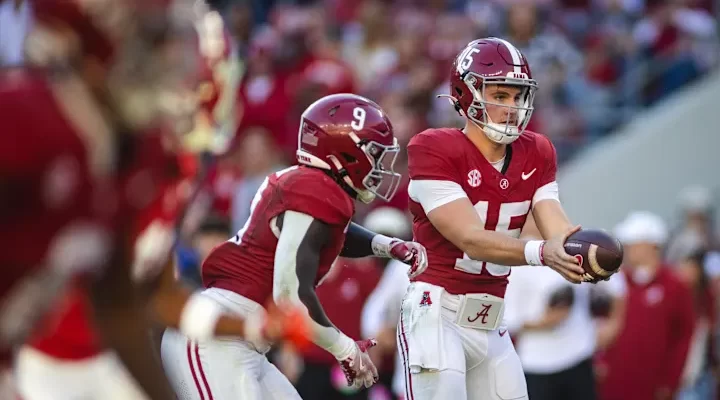Alabama Eyes the Future: Inside the Crimson Tide’s Approach to the 2025 Quarterback Battle
As Alabama football ushers in a new era under head coach Kalen DeBoer, the battle for the starting quarterback position in 2025 is already shaping up to be one of the most closely watched storylines in Tuscaloosa. With the departure of Jalen Milroe on the horizon and a reshuffling of priorities within the program, the Crimson Tide coaching staff has turned its focus toward identifying, developing, and ultimately choosing the right quarterback to lead the team into the future. And while the 2025 season may feel distant to fans, Alabama is already laying the groundwork for what could be one of the most competitive quarterback showdowns in recent memory.
Alabama’s approach to this battle is deliberate, calculated, and very much rooted in the culture of precision and preparation that has long defined the program. Even though the transition from Nick Saban to DeBoer marks a philosophical shift in some areas, the high standards remain unchanged. Quarterback is the most important position on the field, and the Crimson Tide are not leaving anything to chance. They’re looking for more than just raw talent—they’re seeking leadership, decision-making, and a mastery of an increasingly sophisticated offensive system.
Kalen DeBoer’s arrival brought with it a new offensive identity—one rooted in rhythm, timing, and quarterback efficiency. Under DeBoer’s watch, quarterbacks are expected not only to manage the game but to elevate it. That means the Tide are looking for someone who can thrive under pressure, process defenses quickly, and make pinpoint throws from the pocket and on the move. It’s a demanding job, and the 2025 QB competition will be a proving ground for those hoping to take the reins of one of college football’s most storied programs.
Several candidates are already in the mix, each bringing a unique blend of skills, pedigree, and promise. Redshirt freshmen and early enrollees are getting reps in practice and film study, and the coaching staff is carefully evaluating each performance. Development is the key focus right now—players are being given the chance to grow into the role before the intensity of next spring’s competition truly begins. Coaches are watching closely for consistency, leadership traits, and an ability to absorb the playbook while maintaining poise under pressure.
This isn’t just about finding the most physically gifted quarterback. Alabama has seen that approach before, and while arm strength and mobility are certainly factors, DeBoer’s staff is emphasizing the mental side of the game. They want a quarterback who can anticipate plays before they happen, adjust protections at the line, and exploit mismatches in real time. In other words, they’re searching for someone who can control the offense as much with their mind as with their arm.
Meanwhile, the staff is also paying close attention to how these quarterbacks carry themselves off the field. In Tuscaloosa, the face of the program isn’t just expected to throw touchdowns—they’re expected to lead in the locker room, represent the university with class, and set the tone for their teammates. How players handle the weight of expectation, the rigors of preparation, and the spotlight of SEC football will all play into who ultimately wins the job.
What adds even more intrigue to the 2025 battle is the shifting landscape of college football. With the transfer portal playing a larger role than ever, quarterbacks now have more options and more power. Alabama must not only develop its own talent but also keep a close eye on external options. Should the current candidates fall short of expectations, it’s not out of the question that the Tide could pursue a veteran quarterback through the portal—a route many top programs have taken in recent years with great success.
That said, the preference within the program remains to develop from within. Building a homegrown starter who understands the system and culture from the ground up is ideal. It creates continuity and allows the staff to mold the quarterback to fit the scheme rather than vice versa. That’s why Alabama is investing heavily in training, giving young quarterbacks a head start in the film room, in workouts, and during situational practices designed to simulate real-game adversity.
Of course, the competition is more than just theoretical. Practices are intense, with every rep, throw, and decision under scrutiny. Quarterbacks are expected to master a high-tempo offense that requires fast processing and accuracy. They’re being pushed to read multiple coverages, adapt on the fly, and maintain composure as the defense throws blitzes and disguised schemes at them. The result is a crucible of pressure—one that will reveal who is truly ready to take on the role of Alabama’s next signal-caller.
Coaches are particularly interested in how each quarterback handles adversity. In a program where expectations are sky-high, the ability to bounce back from a bad throw or a poor decision is crucial. It’s not enough to shine during seven-on-seven drills—quarterbacks must show resilience, leadership, and a short memory when things go wrong. The coaching staff has emphasized that mistakes will happen; it’s the response that matters.
Another major element of the quarterback evaluation centers on game management. With DeBoer’s system emphasizing balance and tempo, quarterbacks must be able to keep the offense in rhythm. That means recognizing when to take shots downfield and when to check down, when to push the pace and when to slow things down. These aren’t decisions that can be coached in real-time—they must become second nature, and the best quarterbacks will demonstrate that instinctively.
Though the 2025 season is still months away, the sense of urgency around the quarterback battle is very real. Alabama knows that in the SEC, the margin for error is razor-thin, and the quarterback often determines whether a team is contending for a national title or simply trying to stay afloat. That’s why every meeting, every rep, and every day of preparation counts.
And while fans may be focused on which name will ultimately be under center, the coaching staff is just as concerned with the process. They’re laying a foundation that will not only determine the 2025 starter but set the tone for the program’s identity in the post-Saban era. It’s about more than winning a single competition—it’s about finding the player who can carry Alabama forward, maintain its standard, and push it to new heights.
What remains clear is that Alabama isn’t approaching this quarterback battle passively. The intensity of their preparation, the depth of their evaluations, and the clarity of their expectations show a program fully engaged in shaping its next chapter. The legacy of quarterback excellence at Alabama—from A.J. McCarron to Tua Tagovailoa, Mac Jones, and Bryce Young—sets a high bar. The player who wins the 2025 job won’t just be handed the keys—they’ll have to earn them every single day.
As the 2024 season unfolds and practice reps accumulate, the contenders for the 2025 quarterback spot will continue to evolve. Some may emerge as frontrunners, others may transfer or shift roles, and new names could enter the mix. But one thing is certain: the competition will be fierce, the standards will be uncompromising, and the quarterback who rises to the top will be battle-tested long before they take their first official snap.
In Tuscaloosa, the next great Alabama quarterback isn’t just being chosen—they’re being forged.



